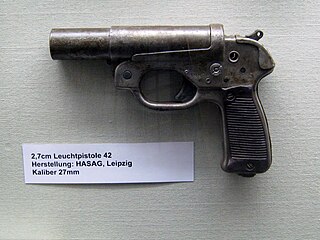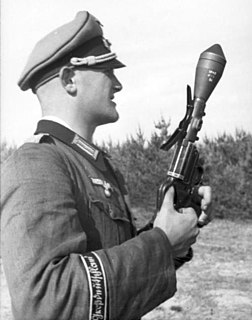 W
WThis article lists all forms of grenade launchers around the world, that is to say weapons that launch grenades with more accuracy, a higher velocity and to greater distances than a soldier could.
 W
WThe Type 10 grenade discharger was a Japanese smoothbore, muzzle loaded weapon used during the Second World War. It first entered service in 1921. The Type 10 has a range of 175 meters, greater than other grenade dischargers of that time. It had a range control device at the base of the barrel in the form of a graduated thimble by which a gas port at the base of the tube could be varied in size. For shorter ranges, part of the propellant gases escape to the side. Due to a translation error, the Type 10 was called the "knee mortar" by the Americans. The manual for the mortar instructed the troops to carry the mortar on the upper thigh, with the base plate attached to the belt and the barrel running down the thigh. It must be understood that it was not strapped or secured directly to the thigh, but hung from the belt. It was also carried strapped to the backpack. American troops on Guadalcanal became aware of the name "knee mortar" and thought the light design allowed it to be fired with the base plate resting on the thigh. If the Type 10 were fired in this manner, it would result in serious injury due to recoil. However, once a few troops injured themselves, the mistranslation was discovered and further experimentation discouraged.
 W
WThe Type 89 Grenade Discharger , inaccurately and colloquially known as a knee mortar by Allied forces, is a Japanese grenade launcher or light mortar that was widely used in the Pacific Theater of World War II. It got the nickname the "knee mortar" because of an erroneous Allied belief that these launchers could be fired by propping its plate against the leg. However, anyone trying to fire it this way would receive a severe bruise from its hefty recoil.
 W
WThe A-91 is a bullpup assault rifle developed during the 1990s by KBP Instrument Design Bureau in Tula, Soviet Union as an offspring of the 9A-91 firearm family.
 W
WThe DP-64 Nepryadva is a Russian special-purpose double-barreled over/under grenade launcher designed to protect surfaced submarines, ships, dockyards, water development works, and other coastal installations from combat swimmers and naval special forces. The weapon is breech-loading and operates much like a large shotgun with a side-break breech, utilizing both direct and indirect iron sights. The weapon is capable of firing grenades indirectly at ranges up to 400 meters; however, these grenades act much like small depth charges, attacking submerged swimmers like true depth charges attack submersibles. A large polymer stock and the barrels themselves makes up the bulk of the weapon. The barrels are selected by turning a lever accommodated above the trigger guard. A front pistol grip is equipped for support and is out of alignment with the rear grip and trigger mechanism, providing a more natural grip while firing indirectly. The butt is fitted with a springy rubber pad to diminish felt recoil. Direct fire sights are also provided for use from a helicopter allowing for large areas to be patrolled and protected from enemy combat swimmers. The grenade launcher was developed in 1989 and introduced in 1990.
 W
WThe DP-65 (98U) is a Russian special compact 55 mm ten-barreled remotely-controlled naval grenade launcher system based on MRG-1 seven-barrel grenade launcher. It also has a manual control mode.
 W
WA grenade launcher is a weapon that fires a specially-designed large-caliber projectile, often with an explosive, smoke or gas warhead. Today, the term generally refers to a class of dedicated firearms firing unitary grenade cartridges. The most common type are man-portable, shoulder-fired weapons issued to individuals, although larger crew-served launchers are issued at higher levels of organisation by military forces.
 W
WThe Kampfpistole or "combat pistol" in English was a flare gun introduced into German service during 1939 and served throughout World War II.
 W
WThe Leuchtpistole 34 or flare gun in English was introduced into German service before World War II and served throughout World War II.
 W
WThe Leuchtpistole 42 or flare gun in English was introduced into German service in 1943 and served throughout World War II.
 W
WThe LGI Mle F1 is a lightweight, close-support infantry weapon designed to be used by one man, to provide indirect-fire, fulfilling the same role as the Japanese Type 89 grenade discharger used during World War II. The LGI has been used by the Foreign Legion and French Army forces since the 1990s and fires high explosive, smoke, and illumination, rounds.
 W
WThe M1 grenade projection adapter was an expedient rifle grenade used by the American military in World War II, Korea, and Vietnam. It consisted of an add-on 22 mm stabilizer tube and fins that converted a hand-grenade into a rifle grenade. It supplanted the M17 rifle grenade, and was eventually made obsolete by the 40 mm M79 grenade launcher.
 W
WThe M7 grenade launcher, formally rifle grenade launcher, M7, was a 22 mm rifle grenade launcher attachment for the M1 Garand rifle that saw widespread use throughout World War II and the Korean War. The M7 was a tube-shaped device, with one end slotting over the muzzle of the rifle and attaching to the bayonet mount, and the other end holding the grenade in place. Blank cartridges were loaded into the rifle prior to firing. When fired, the expanding gases generated by the cartridges propelled the grenade forward with considerable force. The M7 could fire grenades up to 200 metres, compared with the maximum of 30 metres achieved by a hand-thrown grenade.
 W
WThe Nahverteidigungswaffe was a roof mounted, breech-loaded, single shot, multi-purpose, 360° rotating grenade launcher that could fire a variety of ammunition. It was typically found on German tanks such as the Panzer IV, Panther I, Tiger I, and Tiger II from 1944 until the end of the war and was intended to replace three previous devices: the Nebelwurfgerät, the Minenabwurfvorrichtung, and pistol ports.
 W
WThe Nebelkerzenabwurfvorrichtung was a rear mounted grenade dispenser used to disperse the Schnellnebelkerze 39 smoke grenade. It was typically found on German tanks from 1939 through 1942.
 W
WThe Objective Individual Combat Weapon or OICW was the next-generation service rifle competition that was under development as part of the United States Army OICW program; the program was eventually discontinued without bringing the weapon out of the prototype phase. The acronym OICW is often used to refer to the entire weapons program.
 W
WThe Panzerwurfkörper 42 was a HEAT grenade that was developed by Germany and used by the Wehrmacht during World War II. The Panzerwurfkörper 42 was designed to be fired from a Leuchtpistole or flare gun in English.
 W
WThe PAPOP was a French project to construct a computerised multi-usage infantry weapon for the FÉLIN system, capable of hitting hidden or protected targets. It would have combined a 35 mm grenade launcher with a 5.56×45mm NATO assault rifle, both in a bullpup configuration, complete with targeting aids.
 W
WThe S&T Daewoo K11 DAW is a multi-weapon resembling the earlier US Objective Individual Combat Weapon in concept, design and operation. It consists of two separate weapons combined into a single unit: a lower assault rifle chambered to fire 5.56×45mm NATO rounds and an upper 20×30mm grenade launcher firing both conventional and air-bursting "smart" grenades, along with its integrated digital sighting unit.
 W
WThe Arbalète sauterelle type A, or simply Sauterelle, was a bomb-throwing crossbow used by French and British forces on the Western Front during World War I. It was designed to throw a hand grenade in a high trajectory into enemy trenches. It was initially dismissed by the French Army but General Henri Berthelot thought it had practical value.
 W
WThe Schiessbecher grenade launcher or Gewehrgranatgerät was used by German forces in World War II. The device was introduced as of 1942 and based on rifle grenade launcher models designed during World War I. The Schiessbecher was intended to replace all previous rifle grenade launcher models.
 W
WA grenade launcher is a weapon that fires a specially-designed large-caliber projectile, often with an explosive, smoke or gas warhead. Today, the term generally refers to a class of dedicated firearms firing unitary grenade cartridges. The most common type are man-portable, shoulder-fired weapons issued to individuals, although larger crew-served launchers are issued at higher levels of organisation by military forces.
 W
WThe Type 2 rifle grenade launcher was an attachment for the Japanese Type 38 and Type 99 rifles that allowed them to fire special hollow charge grenades. It was a version of the German Schiessbecher grenade launcher. Two grenades were produced for the launcher: a 30 mm calibre grenade and a larger 40 mm calibre grenade, both designated Type 2. The launcher sits over the end of the barrel, held in place with a clamping device. A special crimped blank cartridge or wooden bullet is used to fire the grenades.
 W
WThe Type 100 grenade discharger was introduced in 1939 as a grenade launcher for the Type 38 and Type 99 Arisaka Rifles. It launches standard Type 91 and Type 99 hand-grenades. The launcher is somewhat unusual in that rather than using the more common cup designs it is a gas trap system, meaning that it incorporates a barrel extension which taps off excess propellant gases to launch the grenade from a cup offset from the barrel. This has the advantage that standard rifle cartridges could be used along with the standard hand-grenades which simplified logistics, at the expense of increased weight and decreased efficiency. The effective range is approximately 100 yards (91 m).
 W
WThe West Spring Gun was a bomb-throwing catapult used by British, Canadian and Australian forces during World War I. It was designed to throw a hand grenade in a high trajectory into enemy trenches.
 W
WThe XM29 OICW was a series of prototypes of a new type of assault rifle that fired 20 mm HE airbursting projectiles. The prototypes were developed as part of the Objective Individual Combat Weapon program in the 1990s. The term SABR was also used at certain points, but is less common.